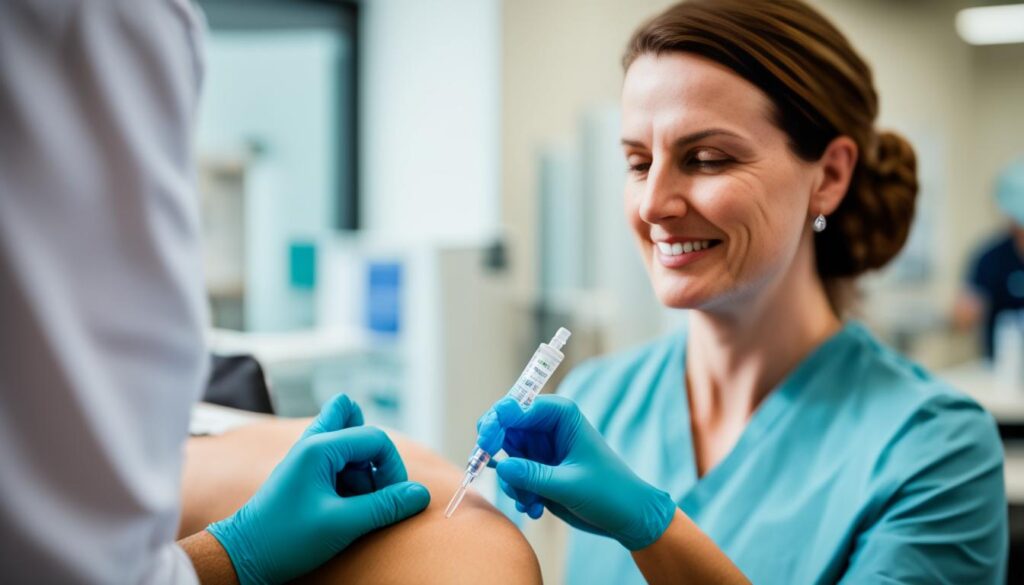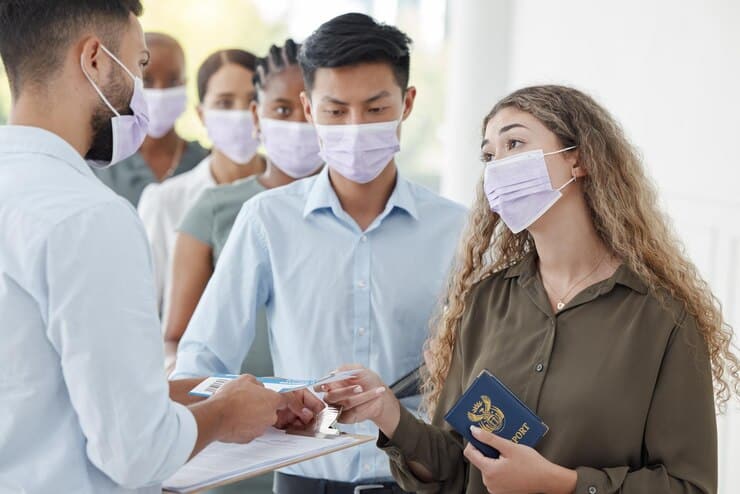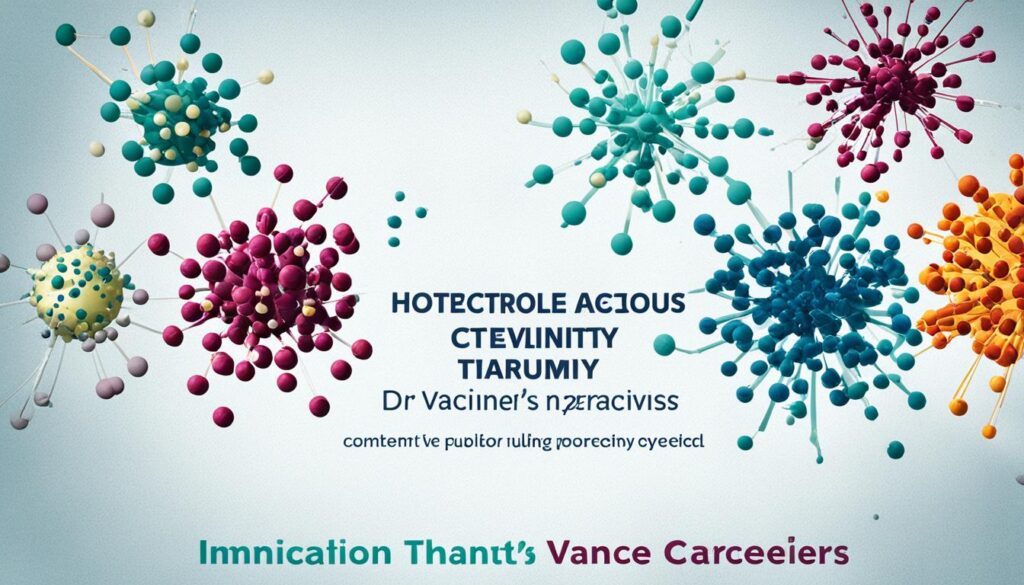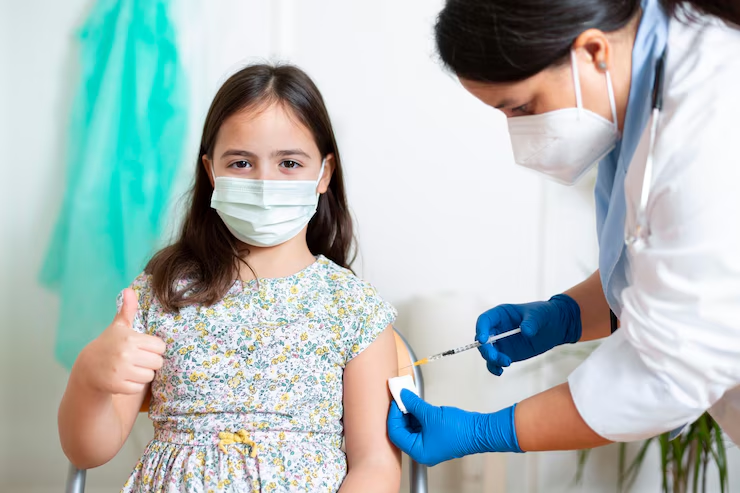Immunization programs are vital achievements in public health around the globe. They rank alongside clean water and better health care access. Immunizations help raise life expectancy and lower child death rates significantly. The World Health Organization says vaccination efforts stop 4 to 5 million deaths each year. In 1980, vaccines achieved the extraordinary feat of wiping out smallpox, a disease that killed 300 million people in the 20th century.
They also helped end polio, tetanus, rubella, and more in many places. Furthermore, immunization efforts have fought against diseases like tetanus, whooping cough, measles, and diphtheria. These diseases once caused many kids to end up in the hospital or led to their deaths.
Key Takeaways :Immunization Services For Public Health
- Immunization programs are among the most significant public health achievements globally.
- Immunizations have led to increased life expectancy and reduced infant mortality rates.
- Vaccination campaigns prevent millions of deaths annually worldwide.
- Vaccines have enabled the eradication and elimination of devastating diseases.
- Immunization programs have controlled numerous vaccine-preventable diseases.
Understanding Immunization Programs
Vaccines are crucial in public health history for raising life expectancy and getting rid of fatal diseases. In the last 200 years, immunization efforts accomplished a lot. They wiped out smallpox and stopped polio, tetanus, rubella, and other diseases in many parts of the world.
Historical Impact on Life Expectancy
Immunizations for kids made a big difference in how long people live. They stopped many diseases from spreading. This lowered the number of kids getting really sick or dying from these diseases.
Disease Eradication and Control
The biggest success story in vaccination is getting rid of smallpox. This disease killed about 300 million people in just the 20th century. Thanks to vaccines, smallpox no longer exists. Immunization efforts also stopped polio, tetanus, rubella, and congenital rubella in many places, controlling their spread.
Recent Vaccine Developments
In the past 20 years, we’ve seen new vaccines fight different health problems. These include those for rotavirus, HPV, meningitis, pneumonia, and shingles. In 2019, Africa started using a malaria vaccine to help children everywhere.
Collective Immunity and Herd Protection

Some vaccines offer strong protection, stopping not only symptoms but also infections. This stops the spread of the disease by people who are vaccinated. If a lot of people are vaccinated, there’s a good chance the disease won’t spread further.
Herd immunity is vital because it protects everyone, even those who can’t get the vaccine. When many people in a community get the vaccine, it makes it hard for the disease to pass on. This helps public health by stopping the spread of certain diseases and makes vaccines more fair and accessible.
It’s also key when talking about making vaccines a must (vaccine mandates). These rules aim to keep the number of vaccinated people high, ensuring that everyone is safe from certain diseases. They want to make sure the benefits are for everyone.
| Vaccine Characteristic | Impact on Herd Immunity |
|---|---|
| Induces robust protection against infection | Reduces pathogen transmission and interrupts its circulation |
| High vaccination coverage in the population | Establishes collective, herd-level immunity |
| Extends benefits to unvaccinated individuals | Enhances immunization equity and access |
| Supports vaccine mandates and policies | Ensures immunization benefits for the entire community |
Studying collective immunity and herd protection helps us see the value of immunization. It shows how effective vaccines are in fighting diseases. This knowledge is key for public health workers, decision-makers, and people in general. They help improve community health and safety.
COVID-19 Vaccines: A Game-Changer

The COVID-19 vaccines have been key in fighting the worst types of the virus. They’ve not just saved lives but also changed how the pandemic spread. Just in the first year since the vaccines were used worldwide, they stopped about 14.4 million deaths from COVID-19.
The number of COVID-19 cases went up a lot due to new, easily spread variants. These variants can get around the immunity caused by past infections or vaccines. Even with this, the situation now is way better than before the vaccines. The disease is less deadly, and fewer people end up in the hospital or with severe problems.
Rapid Development and Distribution
The COVID-19 vaccines were made and given out really quickly. This shows the power of having widespread vaccination plans. Getting people to know about vaccines and how they help is crucial for keeping everyone healthy. This success teaches us how to better prepare and control future health crises.
Mitigating Severe Disease and Mortality
The COVID-19 vaccines are vital in making the virus less deadly and reducing severe cases. It’s clear that accepting vaccines and having good ways to give them are important for community health. The experiences from vaccine rollouts will guide how we handle new health threats with immunizations.
Disruptions in Routine Immunization

In 2020, as SARS-CoV-2 was spreading worldwide, many immunization services for public health faced big problems. Travel restrictions and policies to limit social contact made it hard for people to get vaccines. Health workers also focused on fighting COVID-19, so less attention went to routine immunizations. This led to more canceled or delayed medical visits.
Challenges During the Pandemic
The pandemic caused a big drop in people visiting vaccination centers. This meant less childhood immunization was happening. Lower childhood immunization increased the risk of vaccine-preventable diseases spreading. Plus, the schedules and records for vaccines got messed up, making it harder for everyone to get their shots when needed.
Declining Vaccination Coverage
Many things led to less immunization protection. There was pressure on the system, making it tough to store and handle vaccines. Also, efforts to educate people about vaccines went down. This all added up to fewer people being protected through vaccinations.
The Resurgence of Vaccine-Preventable Diseases

1 in 5 children around the world is still not getting vaccinated. Vaccines have done so well that people now forget how bad these diseases can be. However, this success has made younger people think the diseases are not a big deal. This has led some parents to not vaccinate their kids, putting everyone at risk of these old diseases coming back.
Underestimating Disease Severity
Many younger people don’t see the big deal in getting vaccines. They haven’t lived through the hard times these diseases caused. This leads to fewer people wanting to get vaccinated. Then, we face higher risks of outbreaks.
Logistical Challenges and Vaccine Hesitancy
There are also problems with getting vaccines to everyone. Things like not having enough vaccines and not getting them where they’re needed are big issues. Added to this, there’s a strong anti-vaccine belief spreading false information. This makes it hard for some communities to get the vaccines they need.
A mix of things like needing to get vaccines, making sure they are available to all, and getting more people to see why vaccines are important are all key. Tackling these issues means we need different efforts. We have to work together to make sure vaccines do their job well, and everyone has the right information.
Immunization Services For Public Health

This difficult time has discussions about challenges and proposals for the resumption of vaccination coverage in children. These talks are happening during and after the COVID-19 pandemic. The article looks at lessons from past pandemics that can help in future health crises. It offers ideas for vaccine development as part of the preparedness for an epi/pandemic.
Resuming Vaccination Coverage
The impact of switching serotypes after vaccination programs with pneumococcal conjugate vaccines gets a close look. It uses Brazil’s efforts as a model. There are tips on how to maintain strong protection against invasive pneumococcal disease.
Preparedness for Future Pandemics
The article discusses what we’ve learned from past pandemics. It gives suggestions for vaccine development as part of the preparedness for an epi/pandemic. These include steps to make sure everyone gets vaccines and health services fairly in future crises.
Addressing Serotype Substitution
The effect of serotype substitution after the implementation of vaccination programs with pneumococcal conjugate vaccines is also explored. Brazil’s approach is highlighted. Suggestions are offered to keep protecting against invasive pneumococcal disease. This involves making sure kids get vaccines on time and keeping good records.
Non-Specific Effects of Vaccines

The article talks about how the BCG vaccine offers protection against many diseases besides tuberculosis. It does so by boosting the body’s innate immune system. This is crucial for ensuring everyone has equal access to vaccines, which is necessary for their success. Especially when focusing on kids and campaigns to increase awareness about vaccines.
Heterologous Protection by BCG Vaccine
The BCG vaccine isn’t just for TB; it also helps fight off other illnesses. There’s growing proof that it can lower the risk of sickness and death from things like respiratory issues and sepsis. It seems to work by altering how our innate immune system functions. This broader protection is key when deciding on vaccination rules and plans to get more people vaccinated.
Immunization for Special Populations
Immunization programs are key to keeping many people healthy, especially those with special health needs. The evidence about vaccination in children with immune-mediated disorders is clear in a detailed study. It provides the latest about vaccines’ safety and effectiveness for these kids.
Vaccination in Children with Immune-Mediated Disorders
The article looks deeply at what’s best for vaccinating kids with immune problems. It guides healthcare workers in making smart choices for these kids’ vaccinations. This ensures they’re protected from serious diseases.
Respiratory Syncytial Virus Immunization Strategies
The study “Current strategies and perspectives for active and passive immunization against Respiratory Syncytial Virus in childhood” dives into new immune technologies. These new methods could soon help beat RSV, a common problem for little ones. If they work, we can save many lives.
HPV Vaccination Programs and Optimized Schedules
The article talks about how to vaccinate better against HPV. Using just one dose could help more people, especially in low- and middle-income countries. It aims to cut down cervical cancer and related issues caused by HPV. This is a big step when getting vaccines everywhere is hard.
COVID-19 Vaccination for Children

The article “COVID-19 vaccination in children: a public health priority” covers vaccinating children against COVID-19. It looks at the good and bad sides of vaccinating kids in countries like Brazil. These areas have high COVID-19 effects, similar to other diseases kids get shots for.
Benefits and Challenges
Vaccinating kids against COVID-19 has big pluses. It lowers their chance of getting really sick, going to the hospital, or facing issues later. This lessens how much strain is on the healthcare system and makes everyone safer.
But, making sure all kids have fair access to vaccines is hard. There’s also the challenge of getting the vaccines to all who need them. Teaching parents about the importance of vaccines and fighting their doubts is also tough.
The article highlights why it’s so important to keep kids’ shots up to date, especially now. It talks about when kids should get vaccines, how to store the shots, and keeping track of who’s been vaccinated. This helps make sure a big vaccine effort for kids across the country is successful.
Also Read : The Health Benefits Of Consuming Dairy Products: What You Need to Know
Conclusion
Immunization services are crucial for public health, as seen in this article. They’ve boosted life expectancy and tackled deadly diseases worldwide. With the COVID-19 pandemic, their significance has become even clearer. Thanks to fast vaccine development, we’re fighting the virus more effectively.
But the pandemic also disrupted routine vaccination efforts. This has increased the risk of diseases making a comeback. Yet, we can overcome this by getting back to high vaccination levels. Tips on tackling hurdles and vaccine hesitancy are crucial for health workers and authorities.
The author hopes this article deepens your understanding of immunization benefits, the importance of vaccines, and how vital vaccination programs are for public health protection. If we stay informed, we can all help make diseases preventable by vaccines a thing of the past. Let’s strive for a world where herd immunity and community immunity are the norm.
FAQs
What are the benefits of immunization programs for public health?
Immunization programs help people live longer and reduce baby deaths around the world. by the vaccines fighting off and removing illnesses like smallpox, poliomyelitis, neo-tetanus, rubella, and congenital rubella. These programs also control tetanus, pertussis, measles, and diphtheria. Before, these diseases caused many kids and teens to get very sick and sometimes die.
How have recent vaccine developments impacted public health?
In the past 20 years, new vaccines have joined the fight and are protecting us. They stop diseases like diarrhea from rotavirus, illnesses from HPV, meningococcal and pneumococcal diseases, and shingles. In 2019, Africa got a new malaria vaccine that could help a lot of children there.
What is the concept of collective immunity or herd protection?
Some vaccines are so good, they not only protect individuals but also stop the illness from spreading. When a lot of people get vaccinated, they create a shield where the disease can’t pass through. This helps keep both vaccinated and unvaccinated people safe.
How have COVID-19 vaccines impacted the pandemic?
COVID-19 vaccines have been a big game-changer, making the disease less dangerous. They are estimated to have prevented about 14.4 million deaths in their first year. Even with new, fast-spreading versions, the vaccines are lowering the risk of getting very sick or needing to go to the hospital.
What were the disruptions to routine immunization services during the COVID-19 pandemic?
The pandemic made it hard to keep up with regular vaccinations. This was because people were traveling less, meeting up less, and health workers were busy with COVID-19. Without as many people coming in for vaccines, there’s a higher chance for diseases to spread.
Why have vaccine-preventable diseases seen a resurgence?
Diseases that we had controlled or almost beaten came back. This happened because people started forgetting how bad these illnesses could be. Also, there were periods when it was hard to get enough vaccines, and some people chose not to get vaccinated.
What are the key challenges and proposals for resuming vaccination coverage?
Some ideas to start vaccinating again are needed. These include plans for COVID-19 and other future diseases. The article talks about changing the pneumococcal vaccine to be more effective against certain types of pneumonia.
What are the non-specific effects of vaccines?
This article looks into how the BCG vaccine helps not just against tuberculosis but also against other infections. It seems to boost the body’s natural defenses, providing overall protection.
How are immunization recommendations for special populations like children with immune-mediated disorders?
The article covers updated info on vaccines for kids with immune issues. It looks at both passive and active vaccine options for RSV and mentions ways to improve HPV vaccine use.
What are the benefits and challenges of COVID-19 vaccination for children?
The paper talks about why vaccinating children against COVID-19 is important. This is especially true in places like Brazil, where the virus has been very serious. It’s compared to other diseases that vaccines can also prevent.
Source Links
- https://www.ncbi.nlm.nih.gov/pmc/articles/PMC10066437/
- https://www.who.int/health-topics/vaccines-and-immunization
- https://www.cdc.gov/vaccines/pubs/pinkbook/strat.html








Leave A Comment